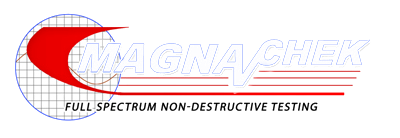Eddy Current Testing is an electromagnetic technique used on conductive materials to detect a number of conditions, including sub-surface defects, variations in material structure, thickness and corrosion.
When an energized coil is brought near to the surface of a metal component, eddy currents are induced into the specimen. These currents create a magnetic field that tends to oppose the original magnetic field. Sub-surface defects will distort the eddy currents and alter the opposing magnetic field. By measuring how the impedance of the coil in close proximity to the specimen is affected by variations in the magnetic field, a skilled operator can precisely locate and classify sub-surface defects.
Eddy Current Inspection is a non-contact procedure that is unaffected by the presence of oils, paints and coatings on the test specimen. This greatly reduces preparation time prior to inspection. Frequently used for on-site inspection for corrosion in heat exchangers tubes, eddy current testing is very fast — making it ideal for high volume sorting of small parts for flaws, size variations and material anomalies.
The Versatility of Eddy Current Inspection
Eddy Current Inspection is used in a variety of industries to find defects and make measurements. One of the primary uses of eddy current testing is for defect detection when the nature of the defect is well understood. In general, the technique is used to inspect a relatively small area and the probe design and test parameters must be established with a good understanding of the flaw that is to be detected. Since eddy currents tend to concentrate at the surface of a material, they can only be used to detect surface and near surface defects. In thin materials such as tubing and sheet stock, eddy currents can be used to measure the thickness of the material. This makes eddy current a useful tool for detecting corrosion damage and other damage that causes a thinning of the material. The technique is used to make corrosion thinning measurements on aircraft skins and in the walls of tubing used in assemblies such as heat exchangers. Eddy Current Testing is also used to measure the thickness of paints and other coatings. Eddy currents are also affected by the electrical conductivity and magnetic permeability of materials. Therefore, eddy current measurements can be used to sort materials and to tell if a material has seen high temperatures or been heat treated, which changes the conductivity of some materials. One of the major advantages of eddy current as an NDT tool is the variety of inspections and measurements that can be performed. In the proper circumstances, Eddy Current Testing can be used for:
Crack detection
Material thickness measurements
Coating thickness measurements
Conductivity measurements for:
Material identification
Heat damage detection
Case depth determination
Heat treatment monitoring
Thinking About Eddy Current? Please Keep A Few Facts In Mind
We will need samples, preferably five good samples and five bad samples. This allows the technician to proceed with a Research and Discovery process. The technician will use these samples to then generate your specification requirements.
Eddy Current Inspection is ideal for high or low production.
We have the capabilities to create a probe specifically for your part and to your needs to be used over and over again.
Limitations
Only conductive materials can be inspected
Surface must be accessible to the probe
Skill and training required is more extensive than other techniques
Surface finish and and roughness may interfere
Reference standards needed for setup
Depth of penetration is limited
Flaws such as delaminations that lie parallel to the probe coil winding and probe scan direction are undetectable
Advantages
Sensitive to small cracks and other defects
Detects surface and near surface defects
Inspection gives immediate results
Equipment is very portable
Method can be used for much more than flaw detection
Minimum part preparation is required
Test probe does not need to contact the part
Inspects complex shapes and sizes of conductive materials



